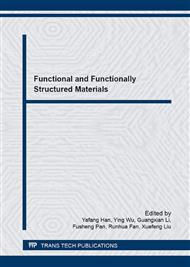[1]
J. H. Yun and J. D. Kim, Double transparent conducting oxide films for photoelectric devices, Mater. Lett. 70 (2012) 4-6.
Google Scholar
[2]
H. Hosono, Recent progress in transparent oxide semiconductors: Materials and device application, Thin Solid Films. 515 (2007) 6000-6014.
DOI: 10.1016/j.tsf.2006.12.125
Google Scholar
[3]
A. N. Banerjee and K. K. Chattopadhyay, Recent developments in the emerging field of crystalline p-type transparent conducting oxide thin films, Prog. Cryst. Growth Charact. Mater. 50 (2015) 52-105.
DOI: 10.1016/j.pcrysgrow.2005.10.001
Google Scholar
[4]
M. Batzill and U. Diebold, The surface and materials science of tin oxide, Prog. Surf. Sci. 79 (2005) 47-154.
Google Scholar
[5]
J. J. Ning, T. Jiang, K. K. Men, Q. Q. Dai, D. M. Li, Y. J. Wei, B. B. Liu, G. Chen and B. Zhou, Syntheses, Characterizations and Applications in Lithium Ion Batteries of Hierarchical SnO Nanocrystals. J. Phys. Chem. C. 113 (2009) 14140-14144.
DOI: 10.1021/jp905668p
Google Scholar
[6]
W. Guo, L. Fu, Y. Zhang, K. Zhang, L. Y. Liang, Z. M. Liu, H. T. Cao and X. Q. Pan, Microstructure, optical, and electrical properties of p-type SnO thin films, Appl. Phys. Lett. 96 (2010) 042113.
DOI: 10.1063/1.3277153
Google Scholar
[7]
Y. Ogo, H. Hiramatsu, K. J. Nomura, H. Yanagi, T. Kamiya1, M. Hirano and H. Hosono, p-channel thin-film transistor using p-type oxide semiconductor SnO, Appl. Phys. Lett. 93 (2008) 032113.
DOI: 10.1063/1.2964197
Google Scholar
[8]
Y. Ogo, H. Hiramatsu, K. Nomura, H. Yanagi, T. Kamiya, M. Kimura, M. Hirano and H. Hosono, Tin monoxide as an s-orbital-based p-type oxide semiconductor: Electronic structures and TFT application, Phys. Status Solidi. A. 206 (2009) 2187-2191.
DOI: 10.1002/pssa.200881792
Google Scholar
[9]
L. Y. Liang, Z. M. Liu, H. T. Cao, Y. Y. Shi, X. L. Sun, Z. Yu, A. H. Chen, H. Z. Zhang and Y. Q. Fang, Improvement of Phase Stability and Accurate Determination of Optical Constants of SnO Thin Films by Using Al2O3 Capping Layer, ACS Appl. Mater. Interfaces. 2 (2010).
DOI: 10.1021/am100236s
Google Scholar
[10]
T. Y. Yang, W. Wen, G. Z. Yin, X. L. Li, M. Gao, Y. L. Gu, L. Li, Y. Liu, H. Lin, X. M. Zhang, B. Zhao, T. K. Liu, Y. G. Yang, Z. Li, X. T. Zhou and X. Y. Gao, Introduction of x-ray diffraction beamline of SSRF, Nucl. Sci. Tech. 26 (2015) 020101.
Google Scholar
[11]
T. Y. Yang, J. Zhao, X. L. Li, X. Y. Gao, C. F. Xue, Y. Q. Wu and R. Z. Tai, Preparation and characterization of p-type transparent conducting SnO thin films, Mater. Lett. 139 (2015) 39–41.
DOI: 10.1016/j.matlet.2014.10.040
Google Scholar


